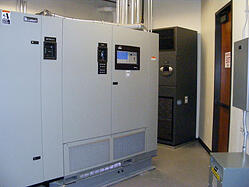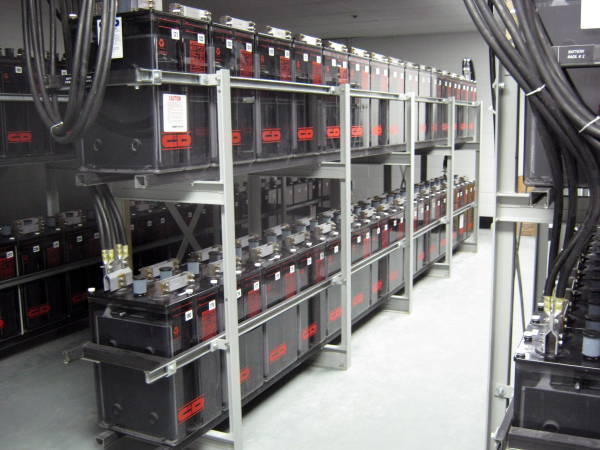Your Uninterruptible Power Supply (UPS) system needs to remain in peak operating cond ition in order to keep your critical facilitiy’s equipment protected during unplanned outages. The loss of any business critical systems can be staggering; therefore – facility and data center managers must perform regular UPS maintenance to make sure critical systems stay running in the chance of a sudden loss of power or voltage drop. In this article, we will talk about UPS maintenance, extending the life of your UPS batteries and capacitor replacement recommendations.
ition in order to keep your critical facilitiy’s equipment protected during unplanned outages. The loss of any business critical systems can be staggering; therefore – facility and data center managers must perform regular UPS maintenance to make sure critical systems stay running in the chance of a sudden loss of power or voltage drop. In this article, we will talk about UPS maintenance, extending the life of your UPS batteries and capacitor replacement recommendations.
Why invest in UPS Maintenance?
The UPS is your main link between the incoming utility or generator power (in the case of an outage) that's supplying all the critical equipment in the data center. It's essentially a series of batteries that will maintain power to critical equipment (computers, servers, and data communication systems) that cannot withstand an interruption. UPS’s are designed to provide constant power during momentary outages and or voltage sags or surges. When a critical facility loses power, it can often take upwards of 10 seconds for the standby generators to power-up and transfer the load to the emergency source and this is not the time to find out it has a problem.
As Benjamin Franklin once said, “an ounce of prevention is worth a pound of cure.” Research shows that scheduled UPS preventive maintenance on a routine basis (weekly, quarterly, semi-annually or annually) extends the useful life of the system and batteries. At EEC, we have been maintaining UPS systems for over 25 years; we recommend regular maintenance on your UPS systems including:
- Weekly (Performed by Customer):
- Visual inspection of environment and space around the UPS and Battery Systems
- Verify no debris (i.e. boxes, computer equipment, etc) is on top of units or obstructing air flow
- Verify cooling is operating in UPS and battery room
- Check UPS panel for any alarms or warnings (call qualified service provider as needed)
- Quarterly (Performed by qualified UPS and/or Battery Technician):
- Take battery voltage and conductance readings for each battery
- Visual Inspection of battery systems and its components, make adjustments as needed.
- Make battery replacement recommendations as needed
- Semi-Annually (Performed by qualified UPS Technician):
- Thermal scan of accessible components in UPS and battery distribution system
- Visual inspection of accessible electrical and mechanical components of the UPS system
- Measure, adjust and record accessible electrical parameters in the UPS system
- Annually (Performed by qualified UPS and/or Battery Technician):
- Place UPS system in Maintenance Bypass
- Visual Inspection of all electrical and mechanical components and connections in the UPS (not accessible during online semi-annual UPS maintenance)
- Measure, adjust and record all electrical parameters in the UPS system (not accessible during online semi-annual UPS maintenance)
- Emergency (i.e. UPS, battery or generator failure or an EPO Event):
- Do not attempt to restore systems to normal operations without speaking with a qualified UPS Service provider.
Frequent testing of UPS equipment will help technicians identify potential issues and min imize problems caused by devastating power interruptions. In the past, a UPS was more difficult to test, and the units often would not notify technicians of low battery capacity. As a result, technicians could not identify potential equipment failures until the actual loss of utility power. These days, many UPS are modular, which enables testing and replacement of certain components of the unit without interrupting full backup to loads being served for the duration intended.
imize problems caused by devastating power interruptions. In the past, a UPS was more difficult to test, and the units often would not notify technicians of low battery capacity. As a result, technicians could not identify potential equipment failures until the actual loss of utility power. These days, many UPS are modular, which enables testing and replacement of certain components of the unit without interrupting full backup to loads being served for the duration intended.
UPS Batteries - the most vulnerable part of any UPS system
The battery is ultimately at the heart of the UPS in terms of reliability. Understanding causes of UPS battery degradation, ways to prevent degradation and maintenance options are fundamental to ensure maximum system availability and are key to data center maintenance.
There are a few ways to extend the life of your data center UPS batteries:
- Purchase the correct battery for your data center - There are many things that factor into the purchase of UPS batteries such as life expectancy, front or top access, voltage, capacity as well as other considerations. Be aware of these, for instance a VLRA (Valve Regulated Lead Acid) battery, while relatively low in cost, has low reliability. While a Flooded or Wet cell battery is much more expensive, it will give you the best reliability and a long service life.
- Is the battery manufacturer qualified by the major UPS manufacturers - Companies like Eaton/Powerware and Liebert/Emerson have qualified battery manufacturers they use for their UPS systems. These battery manufacturers include: C&D, GNB and Enersys.
- Is the battery fresh or surplus stock that has been sitting on a shelf - Batteries should not stay longer than six months without recharging. Many times when you see a cheaper price it’s due to a distributor trying to sell "aging" inventory. It is difficult and labor intensive to recharge "aging" batteries and if these batteries remain on the shelf too long and are not properly recharged they will need to be scrapped. Bottom line; make sure the date codes on the batteries are within six months from the date you received them. Otherwise you may be getting a five year product that is a year or more old.
- Install, manage and maintain batteries properly - Proper installation of the batteries is important and if not done correctly can lead to shortened battery life. These batteries are sensitive to room temperature, so a good maintenance practice is to keep them as close as possible to 77 degrees Fahrenheit. You need to make sure they are all kept as close to this temperature as possible so that some batteries don’t age faster than others, this can make the batteries die quicker.
- Make sure you have regular inspections of your batteries - the visual portion can unveil problems such as damaged or leaking post seals that can lead to corrosion or fires. Taking readings will tell you if one or more is not operating correctly due to a variety of reasons. A short within a cell will cause a lower float voltage on a battery. A battery with an open cell or low capacity may have a higher float voltage on it. The main problem is if one battery in a string that is wired in series (typical UPS application) starts to fail or fails it will affect the remaining batteries.
- Keep an eye on the battery's discharge status - if a battery isn’t recharged within 48 hours it can lead to damage.
At EEC our UPS battery replacement and UPS battery maintenance philosophy  is designed around detecting and correcting potential issues before they become problems that cause system failure and cause your data center to lose power. Over 90% of UPS failure is attributed to battery failure, so when inspecting UPS batteries we look for leaking cells, cracked cases, and sulphation to name a few issues. Temperature, voltage, and conductance are also measured, tracked, and analyzed. Trending the results of these areas allows EEC to predict a majority of failures before they occur and protect our customer’s critical infrastructure. We offer our customers access to view and monitor the trending of their UPS batteries through battery trending tools available in our Infrastructure Manager system that is provided to our contract customers at no cost.
is designed around detecting and correcting potential issues before they become problems that cause system failure and cause your data center to lose power. Over 90% of UPS failure is attributed to battery failure, so when inspecting UPS batteries we look for leaking cells, cracked cases, and sulphation to name a few issues. Temperature, voltage, and conductance are also measured, tracked, and analyzed. Trending the results of these areas allows EEC to predict a majority of failures before they occur and protect our customer’s critical infrastructure. We offer our customers access to view and monitor the trending of their UPS batteries through battery trending tools available in our Infrastructure Manager system that is provided to our contract customers at no cost.
AC and DC Capacitors
A less heard of topic in the UPS system are the AC and DC capacitors banks; made up of both DC electrolytic and AC polymeric film capacitors. These capacitors are used for filtering and both degrade under field operating conditions. DC electrolytic capacitors are used to filter the DC signal and AC polymeric film capacitors are used for filtering the AC signal. The DC capacitors are also used to hold the DC bus voltage at a near constant level. Without the capacitor filters the UPS system would supply poor quality power, which is not an adequate AC source for highly reliable systems.
Over time both AC and DC capacitors age, suffering from a deterioration of materials due to usage as well as chemical reactions such as heat and chemical contaminates. These chemical reactions lead to an increase in the probability that the dielectric material will not withstand the applied voltage and they become less effective and start to fail. As capacitors fail in a capacitor bank, those that remain must work harder and the probability of additional failures is high. Because the individual capacitors are assembled into capacitor banks, the capacitor bank needs to be removed from the UPS system in order to replace a single capacitor. Once the capacitor bank has been removed from the UPS system, the additional time to replace all the capacitors is a small incremental investment.
Experience has shown that AC and DC capacitors should be replaced before they fail, typically every five to seven years.
Other thoughts for your UPS systems
Old, inefficient UPS systems can be replaced and pay for themselves within a few years just from the energy savings. Many newer UPS systems also feature advanced monitoring systems that provide system status for such items as system voltages, battery-backup times, and battery-test schedules. Other information included in monitoring includes whether the UPS operates on batteries, utility power or maintenance bypass.
Many systems can page technicians and provide information in the event a problem arises. This information can be very helpful, especially in cases where technicians are not on site or the facility is monitored remotely. Some UPS system also can conduct a controlled shutdown for computers in a network when a low-battery warning occurs. Like any piece of critical equipment, the UPS and all of its subsystems must be on a constant monitoring and maintenance program to ensure peak performance.
For over 26 years, EEC has been designing and maintaining data centers and their critical power and cooling systems. Our preventive maintenance visits serve as an in-depth examination of specific equipment, as well as a general review of the site conditions--our goal is to minimize unscheduled emergency visits and keep your facility up and running continuously. For more information, a UPS maintenance quote or to schedule a free UPS system consultation, please click the button below, call us at 800-342-5332 or email sales@eecnet.com.


